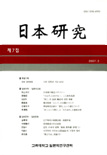- 영문명
- 발행기관
- 고려대학교 글로벌일본연구원
- 저자명
- 安志英
- 간행물 정보
- 『일본연구』第13輯, 247~266쪽, 전체 20쪽
- 주제분류
- 인문학 > 문학
- 파일형태
- 발행일자
- 2010.02.28

국문 초록
영문 초록
The purpose of this thesis is to analyze the origin of the compound particles 「tokoroga」 and 「tokorode」 and follow the integration of the compound particles in language over time. The following information was derived as a result of the analysis
(1) The compound particle 「tokoroga」 seems to have originated during the Meiji periods and was initially used more commonly as a contrary conjunction rather than a conditional conjunction because the contrary particle 「ga」 had a stronger effect than 「tokoro」. With passage of time, 「tokoro」 gradually became more commonly used as a conditional conjunction due to the strong linkage of the word to scenic presentations. As a result of language development, 「tokoro」has become a compound particle in common language use today.
(2) The first known appearance of 「tokoroga」 in Japanese literature was in the year gyokuzinsyou 1563 and it was originally used as a contrary conjunction. However, it was not used ever again in the Kamigata dialects until the Edo periods.
(3) During the Meiji periods, as the new compound particles 「-temitatokoroga」 and 「-nisitatokoroga」 began to be used, 「tokoroga」 became more widely used as a contrary conjunction.
(4) The form of the compound particle 「tokorode」 transformed over time from 「tokoronite」 to 「attributive + tokorode」 to its final form 「tatokorode」 during the 16th century.
(5) The first known appearance of 「tokorode」 in Japanese literature Tyukaz -yakubokusisyou was approximately in the year 1520 and it was originally used as a conditional conjunction.
(6) The compound particle 「tokorode」 is commonly used as a conditional conjunction in the meaning of fact. However, there is some evidence that it was also used as a conditional conjunction in the meaning of supposition in the Kamigata dialect.
(7) During the Meiji periods, new compound particles emerged in addition to 「to korode」, including 「-tositatokorode」, 「-temitatokorode」 and 「-nisitatokorode」. The compound particle 「tokorode」 was considered a conditional conjunction of supposi tion as a result of the usage of adverbs such as 「tatoi」, 「yoshinba」, 「karini」, and 「yosi」.
목차
Abstract
1.はじめに
2.調査資料及び考察方法
3.各作品に見られる 「ところが」の樣相
4.各作品に見られる 「ところで」の樣相
5.おわりに
參考文獻
키워드
해당간행물 수록 논문
참고문헌
최근 이용한 논문
교보eBook 첫 방문을 환영 합니다!

신규가입 혜택 지급이 완료 되었습니다.
바로 사용 가능한 교보e캐시 1,000원 (유효기간 7일)
지금 바로 교보eBook의 다양한 콘텐츠를 이용해 보세요!


